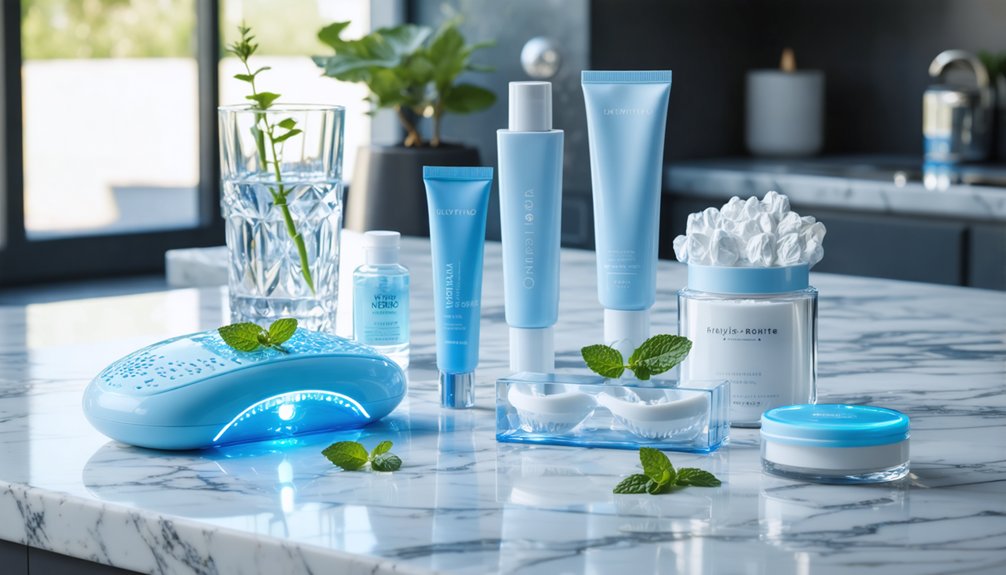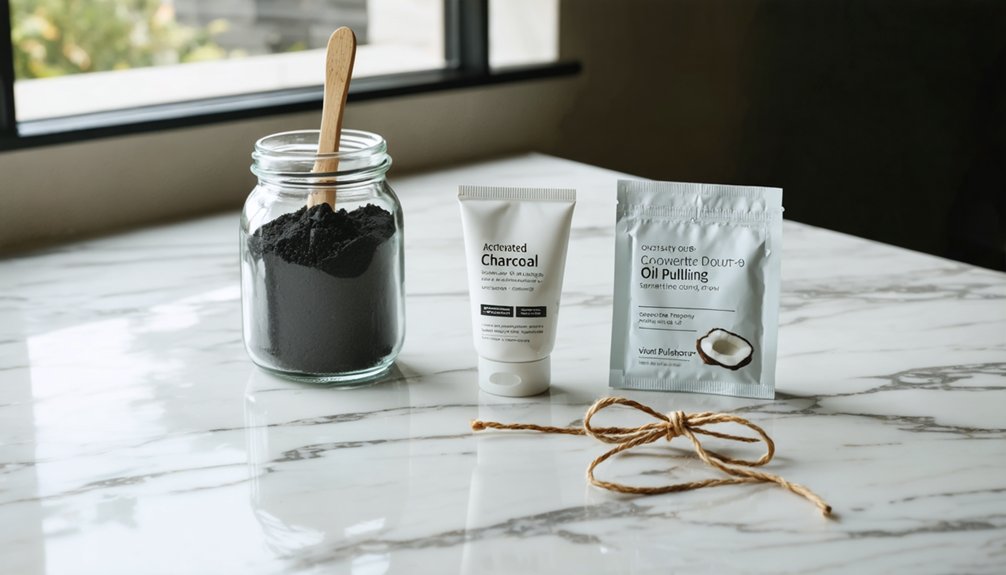You can achieve professional whitening results with sensitive teeth by choosing specialized products that protect enamel while lifting stains. Consider low-peroxide whitening strips, LED systems with cooling technology, or custom-fitted trays with sensitivity-tailored gels. Desensitizing toothpastes containing potassium nitrate and stannous fluoride offer added protection, while natural alternatives like coconut oil provide gentle options. Professional whitening pens enable precise application for targeted results. Learn seven proven solutions to brighten your smile comfortably and effectively.
Key Takeaways
- Desensitizing toothpaste containing 5% potassium nitrate and stannous fluoride provides dual protection while preparing teeth for whitening treatments.
- Low-peroxide whitening strips with Dead Sea salt and essential oils effectively remove stains in 30 minutes without causing sensitivity.
- LED whitening systems with zero-sensitivity formulations and cooling technology remove deep stains while protecting sensitive teeth.
- Custom-fitted tray systems allow dentists to prescribe specific gel concentrations based on individual sensitivity levels.
- Whitening pens with lower peroxide concentrations offer precise application and gentle whitening for sensitive teeth.
Understanding Your Sensitive Teeth Before Treatment
Before pursuing any teeth whitening treatment, understanding the nature of your tooth sensitivity is essential for achieving safe and comfortable results.
If you experience sharp, sudden pain when consuming hot, cold, or sweet items, you’ll need to identify these sensitivity triggers before proceeding with treatment.
Your sensitivity may stem from exposed dentinal tubules due to enamel loss or receding gums, which affects up to 40% of the population.
Women and younger individuals often report higher sensitivity rates.
Sharp pain can be triggered by acidic foods and beverages which gradually wear down protective tooth enamel.
Poor brushing techniques can contribute to increased tooth sensitivity by damaging enamel and gum tissue.
To develop an effective pain management strategy, you’ll need to determine if your sensitivity is localized to specific teeth or generalized, and whether it’s triggered by mechanical pressure or temperature changes.
Understanding these patterns helps differentiate between routine sensitivity and underlying dental conditions that require attention before whitening.
Best Low-Peroxide Whitening Strips for Gentle Results
If you’re seeking gentle teeth whitening solutions, low-peroxide and non-peroxide strips offer effective results while minimizing sensitivity and discomfort.
You’ll find these gentler options can achieve significant whitening within 30 minutes, showing color changes visible to the naked eye without compromising enamel integrity.
When applying sensitivity-safe strips, maintain consistent contact with your teeth’s surface while avoiding gum tissue to maximize results and prevent irritation. Clinical evaluations showed excellent strip retention throughout the full treatment period.
A study of 50 participants found that non-peroxide strips containing Dead Sea salt and essential oils demonstrated effective whitening without the side effects common to peroxide-based products.
Gentle Whitening Strip Options
While traditional teeth whitening products often cause discomfort, gentle whitening strips with low-peroxide formulations offer an effective alternative for those with sensitive teeth. These strips typically contain 3-10% peroxide concentrations, providing gradual whitening while minimizing sensitivity risks. Results can remain visible for several months with proper maintenance.
You’ll find that gentle formulations can effectively target extrinsic stains from coffee, tobacco, and food pigments through mild oxidation processes. Some strips combine low-peroxide content with desensitizing agents like potassium nitrate for enhanced comfort during treatment. Daily use for one to two weeks delivers optimal whitening results.
Non-peroxide options are also available, achieving significant color changes after just 30 minutes of wear while maintaining excellent tooth and gum safety profiles.
For effective results without compromising comfort, look for strips that adhere well to teeth and maintain their integrity throughout the recommended wear time. These gentler options help preserve enamel structure while still delivering visible whitening improvements.
Sensitivity-Safe Application Tips
Successful teeth whitening with low-peroxide strips depends on precise application timing and careful technique to minimize sensitivity.
Understanding common whitening myths and sensitivity triggers helps you achieve ideal results while protecting your teeth. Proper timing, gentle application, and post-treatment care greatly reduce discomfort during the whitening process.
- Apply strips for exactly 30 minutes in the morning when saliva flow naturally protects enamel.
- Press strips firmly against teeth without overlapping gums, ensuring complete coverage for uniform whitening.
- Remove strips gently and rinse with lukewarm water to eliminate residual peroxide.
- Wait 24-48 hours between applications, avoiding hot, cold, or acidic foods that can trigger sensitivity.
Use desensitizing toothpaste before and after treatment to strengthen enamel and maintain comfort throughout your whitening journey.
Professional-Grade LED Whitening Systems for Home Use
Professional-grade LED whitening systems bring clinical-level teeth whitening capabilities into your home through advanced light-activation technology.
These systems combine powerful LED technology advancements with user friendly designs, featuring dual-light outputs and precision cooling mechanisms that protect your enamel while accelerating the whitening process.
You’ll find these devices equipped with multiple timer modes and comfortable mouthpieces, making treatments both precise and convenient.
Many systems can remove up to 10 years of stains within three days, achieving up to eight shades lighter within a week.
The latest models incorporate zero-sensitivity formulations and heat-activated technology to minimize discomfort while maximizing results. These professional systems are enamel safe and clinically proven to deliver excellent results. Dental professionals trust these LaserGlow LED systems for delivering exceptional whitening outcomes in both clinical and home settings.
With integrated timing controls and included whitening gels, you can safely replicate professional whitening results while maintaining ideal enamel protection at home.
Desensitizing Toothpastes With Whitening Properties
If you’re planning to whiten your sensitive teeth, you’ll benefit from using desensitizing toothpaste before and during the whitening process to minimize discomfort.
These specialized formulations contain potassium nitrate (5%) to calm nerve responses while incorporating gentle whitening agents like hydrated silica for stain removal. Sodium fluoride content of 0.24% provides added cavity protection. Common brands like Sensodyne combine stannous fluoride for maximum sensitivity protection.
The dual-action protection helps strengthen your enamel through remineralization while gradually lightening tooth color, making it an essential part of any sensitivity-conscious whitening routine.
Dual-Action Protection Benefits
Modern dual-action toothpastes offer a powerful combination of desensitizing and whitening properties through carefully balanced formulations.
These advanced products utilize both occlusive agents and nerve-calming compounds to address sensitivity while incorporating gentle whitening mechanisms that won’t compromise tooth comfort.
- Desensitizing agents like arginine, stannous fluoride, and potassium compounds work to block exposed dentin tubules or reduce nerve responses.
- Stabilized whitening components lift stains without increasing sensitivity.
- Low-abrasion formulas protect enamel while effectively removing surface discoloration.
- Active ingredients are precisely concentrated (5% potassium nitrate, 10-19% mineral compounds) to guarantee clinical efficacy.
Scientific evidence confirms these dual-action toothpastes effectively manage both sensitivity and aesthetics, allowing you to confidently recommend them to patients seeking thorough care.
Pre-Treatment Sensitivity Management
Effective sensitivity management prior to whitening treatment requires strategic use of desensitizing toothpastes containing dual-action ingredients.
You’ll find that pre-treatment options featuring 5% potassium nitrate offer significant protection while maintaining whitening effectiveness. Before beginning any whitening regimen, conduct a sensitivity assessment to determine if your patient needs higher-fluoride solutions like PreviDent 5000 Sensitive.
For ideal results, recommend twice-daily brushing with potassium nitrate toothpaste before and during treatment.
Products containing hydroxyapatite or tricalcium phosphate provide enhanced protection through enamel remineralization and tubule occlusion. These ingredients are particularly effective when treating patients with existing sensitivity concerns.
You’ll achieve better outcomes by selecting products that match your patient’s specific bleaching protocol, as desensitizing effectiveness varies with different peroxide concentrations and application methods.
Natural and Chemical-Free Whitening Alternatives

For individuals seeking gentler teeth whitening solutions, several natural alternatives offer promising results without harsh chemicals.
Natural oils like coconut oil, through oil pulling, can help maintain oral hygiene and reduce bacteria that cause yellowing. Similarly, baking soda provides mild abrasive action to lift surface stains while being gentler on sensitive teeth.
- Practice oil pulling with coconut oil for 15-20 minutes daily to reduce plaque and support oral health.
- Use baking soda paste moderately, avoiding aggressive scrubbing to protect enamel integrity.
- Incorporate fruits and vegetables into your diet to promote natural cleaning effects.
- Maintain consistent oral hygiene to prevent stain buildup and minimize the need for intensive whitening treatments.
Remember that while these methods may be gentler, their whitening effects are more subtle than chemical treatments but safer for sensitive teeth.
Custom-Fitted Tray Systems for Controlled Application
Custom-fitted tray systems represent a significant advancement in sensitive teeth whitening, offering precise control and ideal results through personalized dental applications.
These trays’ key advantages include perfect anatomical matching to your teeth, guaranteeing uniform coverage and minimizing gel contact with sensitive gum tissue.
You’ll experience superior whitening effectiveness through controlled gel application, as custom trays keep the bleaching agent firmly in place without leakage.
Your dentist can prescribe specific gel concentrations tailored to your sensitivity levels, optimizing results while reducing discomfort.
The reusable nature of custom trays allows you to whiten at your convenience and maintain results through periodic touch-ups.
While the initial investment may be higher than over-the-counter alternatives, you’ll benefit from longer-lasting results and professional oversight that guarantees both safety and effectiveness.
Dentist-Approved Whitening Pens and Spot Treatments

Dentist-approved whitening pens offer a targeted approach to teeth whitening, featuring precise applicators that deliver controlled amounts of peroxide-based gel directly to stained surfaces.
The whitening gel formulation contains lower concentrations of peroxide compared to professional treatments, making it suitable for sensitive teeth while still effectively removing surface stains.
For best results with pen application techniques:
- Brush your teeth thoroughly before applying the whitening gel
- Apply a thin, even layer to visible tooth surfaces using gentle strokes
- Allow the gel to remain on teeth for 20-30 minutes undisturbed
- Avoid eating, drinking, or rinsing immediately after treatment
You’ll typically notice initial brightening within a week of twice-daily use, though results are more subtle than in-office treatments.
The gentle formulation helps minimize sensitivity while gradually improving your smile‘s appearance.
Frequently Asked Questions
How Long Should I Wait Between Whitening Treatments if My Teeth Are Sensitive?
You’ll need to wait at least 8 weeks between treatments for proper sensitivity management. If you’re using professional in-office whitening, extend treatment intervals to 6 months to protect your enamel.
Can Certain Medications Affect Tooth Sensitivity During Whitening Procedures?
Yes, your medication types can impact sensitivity levels during whitening. Antibiotics, anti-inflammatories, and drugs affecting saliva production may alter how your teeth respond to whitening agents and peroxide exposure.
Will Teeth Whitening Make Existing Dental Work Appear Different Colored?
Yes, teeth whitening won’t change the color of your existing dental work, causing noticeable differences. Your natural teeth will lighten while restorations like crowns, fillings, and veneers remain their original shade.
Does Drinking Through a Straw Prevent Staining After Whitening Treatment?
While straw benefits include reduced contact between staining drinks and front teeth, it’s not a complete solution. You’ll need additional whitening techniques and good oral hygiene to maintain your whitening results.
Can Seasonal Temperature Changes Impact Tooth Sensitivity During Whitening?
You’ll experience increased seasonal sensitivity during whitening when exposed to temperature effects, as your teeth become temporarily more porous and reactive to both hot and cold environmental stimuli.
References
- https://smiledailey.com/teeth-whitening-for-sensitive-teeth-is-it-safe/
- https://www.trysnow.com/blogs/news/best-teeth-whitening-products-for-sensitive-teeth
- https://www.purpleplumdentistry.com/post/best-teeth-whitening-options-for-sensitive-teeth
- https://www.westriverdentalcare.com/best-teeth-whitener-for-sensitive-teeth/
- http://www.goochlanddentistry.com/whats-the-best-teeth-whitener-for-sensitive-teeth/
- https://pmc.ncbi.nlm.nih.gov/articles/PMC4058574/
- https://nhdentistrybeverlyhills.com/press/6-of-the-best-teeth-whitening-kits-in-the-drugstore/
- https://pmc.ncbi.nlm.nih.gov/articles/PMC7448347/
- https://professional.sunstargum.com/en-en/news-events/tooth-sensitivity-facts-and-research-for-professionals.html
- https://www.premierdentalohio.com/blog/the-facts-about-sensitive-teeth



